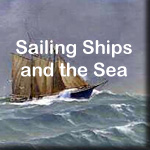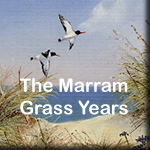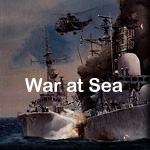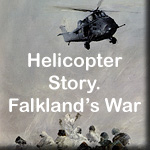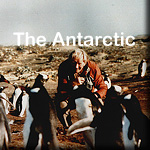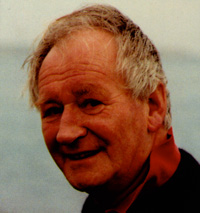 John
Hamilton was born in 1919 and was educated at Bradfield
College, England. He served throughout the Second World
War in The Queen's Royal Regiment in India and at the age
of 24, was awarded the Military Cross.
John
Hamilton was born in 1919 and was educated at Bradfield
College, England. He served throughout the Second World
War in The Queen's Royal Regiment in India and at the age
of 24, was awarded the Military Cross.
In 1961 he moved to the island of Tresco, in The Isles of Scilly, where he enjoyed painting and drawing as a hobby, as time would allow. It was not however until he was 53, after a bout of angina, that he sold his business and turned to painting professionally.
Sailing ships and the sea
His studio quickly became popular with the many people visiting these beautiful islands. He painted island scenes, the sea and traditional sailing ships, but gradually his interest turned to researching and recording the historical naval battles of the 1939-45 war.
The War at Sea
His first series, the War in the Atlantic, took seven
years to complete and consisted of 84 paintings. Rather
than produce a one sided view, he was determined to
create as accurate account as possible, showing the
triumphs and failures of both sides. He talked to
veterans and visited archives in England, Germany and
later the USA and Japan, often changing pictures many times based on
his discussions with eye witnesses. This series was bought by a group of shipping lines and donated to the Imperial War Museum, London. It hung for many years aboard H.M.S.
Belfast, but is now at the National Maritime Museum, Greenwich, London.
The War in the Pacific, completed 5 years later, was an even greater project, consisting of 120 paintings ranging in size from 24" x 36" to 40" x 60". The collection was bought by the US Navy and is part of the Navy Art Collection at the Navy Yard in Washington. Paintings are loaned to The Pentagon and other qualified borrowers. See or purchase prints.
176 of the 204 paintings from the two series form the basis of his book The War at Sea 1939-45 (ISBN 0-7137-1660-6) which has become a collector's item.
The Falklands Campaign
His next endeavor depicted the crucial role of the helicopter in the Falklands War. While researching the project, which took 4 years to complete, he visited The Falkland Islands three times, making trips to every spot where helicopters were involved in action. Forty-six of the paintings feature in his book 'The Helicopter Story of The Falklands Campaign' (ISBN 0-7153-9286-7). The paintings are spread through several collections, but the last nine originals were bought by The Falkland Islands after the artist's death and hang in the school library in Stanley, for the benefit of all islanders - a fact that would have given him great pleasure.
The Marram Grass years
These projects were not prepaid commissions, so to pay
his bills during the years of research, he painted local
scenes, primarily of beaches and bird life. He jokingly
called these The Marram Grass years, but these paintings
enabled him to keep pursuing his main interest. Limited
edition prints of these pictures are still available.
The Antarctic
In later years he developed a love for The Antarctic and, though in his 70's, spent two winters there aboard H.M.S. Endurance, courtesy of The British Navy. He was flown by helicopter into the interior and painted some magnificent scenes of this lonely landscape, as well as recreations of Shackleton's expedition and documentation of the old buildings left by these and other brave men.
He was the inspiration and a founding member of 'The United Kingdom Antarctic Heritage Trust' which, under the patronage of Princess Anne, raises money to preserve the artifacts and huts of early explorers and to inform and educate the British people about their Antarctic heritage.
He died in 1993, but the gallery in St. Marys remained open until 1997, run by his wife Betty.

